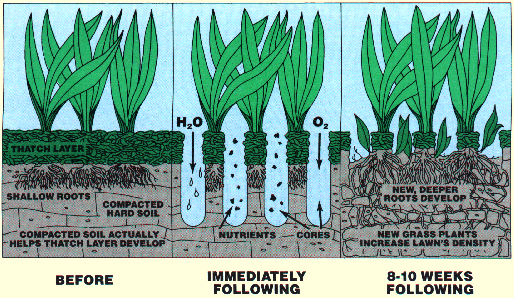Aeration and Dethatching
Why Should You Aerate Your Lawn?
Creating and maintaining quality turf grass involves more than irrigation and fertilization. A dense healthy turf grass requires proper mowing practice and aerification.
Healthy grass plants require strong root systems. Grass plants also require healthy soil and conditions which provide them the opportunity to absorb water, oxygen and nutrients from the soil. It is important to remember that deep vigorous root systems are the key to healthy turf. In the make up of good soils, material and organic matter comprise about 50% of normal volume. The remaining 50% of the volume is open pore space. Ideally, about half of the pore space is filed with air and the other half with water.
Soil compaction is one of the most significant enemies to a healthy lawn. It is caused by children’s play, foot traffic, mowing, parked cars, heavy rains, and possibly construction equipment. The severity will vary according to the make-up of your soil.
Because of compaction, when soil particles are pressed together, there is reduced soil pore space (the spaces between soil particles); decreased movement of water and air into and within the soil; decreased soil water storage; and increased surface accumulation and erosion. Rain waters tend to run off rather than soak in, oxygen needed to support the grass plants and the healthy microbes in the soil is restricted.
A lawn that is properly cared for allows more air, water and nutrients to reach deeper down to the root zone. In heavy clay soils aeration may be necessary every year.
Lawncare and Landscaping
Does Your Lawn Need Dethatching?
Perform one or more of these tests to determine whether your lawn needs dethatching.
Feel the lawn. A lawn that’s spongy or bouncy underfoot, with a springy feel, often has a thick thatch layer.
Visually inspect the lawn. To determine how thick thatch is, examine the lawn closely. Is soil visible between turf crowns? If it isn’t, you’re likely looking at a thatch layer. Can you shove your finger through the visible thatch layer – or is it impenetrable? A thatch layer that’s tough to wedge a finger through needs to be thinned.
Measure the thatch. Another way to examine thatch is to excavate a lawn sample. Use a trowel or spade to remove a wedge-shaped layer of grass and soil about 3 inches thick, or just pry up a small section of turf. Look for the thatch layer lying directly on top of soil. Measure the thickness. A layer thicker than three-quarters of an inch signals it’s time to dethatch.
Power Raking (Dethatching) or Core Aeration? That is the question!
Posted on August 25, 2015 by jahoyle
(By Ward Upham and Jared Hoyle; KSU Research and Extension)
September is the optimum time to power rake or core-aerate tall fescue and Kentucky bluegrass lawns. These grasses should be coming out of their summer doldrums and beginning to grow more vigorously. This is a good time to consider what we are trying to accomplish with these practices.
Power raking is primarily a thatch control operation. It can be excessively damaging to the turf if not done carefully. For lawns with one-half inch of thatch or less, I don’t recommend power raking but rather core aeration. For those who are unsure what thatch is, it is a springy layer of light-brown organic matter that resembles peat moss and is located above the soil but below the grass foliage. Power raking pulls up an incredible amount of material that then must be dealt with by composting or discarding.
Core-aeration is a much better practice for most lawns. By removing cores of soil, core-aeration relieves compaction, hastens thatch decomposition, and improves water, nutrient, and oxygen movement into the soil profile. This operation should be performed when the soil is just moist enough so that it crumbles easily when worked between the fingers. Enough passes should be made so that the holes are spaced about 2 to 3 inches apart. Ideally, the holes should penetrate 2.5 to 3 inches deep. The cores can be left on the lawn to decompose naturally (a process that usually takes two or three weeks, depending on soil-type), or they can be broken up with a power rake set just low enough to nick the cores, and then dragged with a section of chain-link fence or a steel doormat. The intermingling of soil and thatch is beneficial to the lawn.


